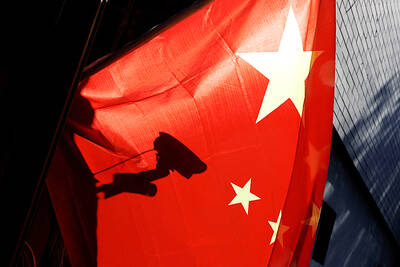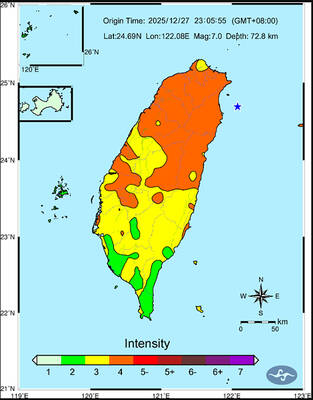Netizens are casting doubt on recent reports that students were paid to take part in a protest against the takeover by Want Want China Times Group of the cable TV channels owned by service provider China Network Systems (CNS), saying the group most likely instigated the reports to attack the protesters.
On Friday, the Chinese-language China Times, China Times Weekly and local news channel CtiTV — all members of Want Want Group — ran stories with pictures showing student protesters taking money after a rally outside the National Communications Commission (NCC) building.
Although the media outlets provided no evidence to back up their claims, the three outlets reported that Academia Sinica research fellow Huang Kuo-chang (黃國昌) may have been involved in paying the students.
Huang had organized a separate demonstration at the same time as the student rally in front of the NCC building because the commission was reviewing the merger at that time. However, reports from the China Times, China Times Weekly and CtiTV did not differentiate between the two demonstrations.
Although Huang organized a press conference denying that he had any connection with the student protest, the media group continued to accuse him of “not wanting to clarify the incident,” while saying he was “not willing to disclose the truth.”
Yesterday, several media outlets, including the Chinese-language Apple Daily, claimed to have discovered the identity of a woman who handed out money to students on Wednesday.
The woman, identified as Liang Li-hui (梁麗惠), is an accountant at Chinsen Communications Co.
While reporters were unable to contact her, Liang’s colleagues said that although they did not know who had hired the company to recruit students, they were certain it was not Huang.
Netizens are increasingly voicing suspicions that Want Want Group may be behind the incident and using it as a way to stigmatize opponents of the takeover.
National Tsinghua University student Chen Wei-ting (陳為廷) posted a picture of the protest that was aired in a CtiTV report, with the China Times Weekly deputy editor-in-chief Lin Chao-hsin (林朝鑫) among the crowd, adding that he suspected Want Want was behind the protest.
Lin denied the accusations, saying he was at the protest because it was his job to report on it, while CTiTV threatened to file a slander lawsuit against Chen.
Want Want China Times Media Group employees accused the media giant of manipulating news reports to attack Huang.
“I feel like dying everyday,” a reporter told the Taipei Times on condition of anonymity. “My name is on news reports attacking Huang, and I’ve seen readers criticizing me for the reports on the Internet, but the fact is that I didn’t produce most of these reports.”
The employee said that his name and the names of several of his colleagues were on the byline of a news report published on Friday implying that Huang was behind the incident.
“In fact, 90 percent of the report came directly from the China Times Weekly and what I wrote was all deleted,” the reporter said. “I complained about this several times, but the management simply ignored me.”
The reporter said many employees within the group feel uncomfortable with what the company asks them to do, with one resigning because of it.
Huang released a statement yesterday, asking Want Want China Times to “stop destroying the dignity of journalists in the group.”
“What Want Want China Times has been doing proves how important it is to resist this media monster, which has no ethics in news reporting,” the statement said.
He also called on the media group to leave his family alone, as reporters from the group have not only been following him around for days, but have also stationed themselves around his house.
Huang said he would be leaving for the US for 10 months on a pre-scheduled research project next week, but added that the project was scheduled last year, and asked the media group to refrain from fabricating so-called news out of it.
He was referring to a report by CtiTV that Huang’s decision to leave Taiwan for so long right after the alleged scandal broke was “suspicious.”

A magnitude 7.0 earthquake struck off Yilan at 11:05pm yesterday, the Central Weather Administration (CWA) said. The epicenter was located at sea, about 32.3km east of Yilan County Hall, at a depth of 72.8km, CWA data showed There were no immediate reports of damage. The intensity of the quake, which gauges the actual effect of a seismic event, measured 4 in Yilan County area on Taiwan’s seven-tier intensity scale, the data showed. It measured 4 in other parts of eastern, northern and central Taiwan as well as Tainan, and 3 in Kaohsiung and Pingtung County, and 2 in Lienchiang and Penghu counties and 1

FOREIGN INTERFERENCE: Beijing would likely intensify public opinion warfare in next year’s local elections to prevent Lai from getting re-elected, the ‘Yomiuri Shimbun’ said Internal documents from a Chinese artificial intelligence (AI) company indicated that China has been using the technology to intervene in foreign elections, including propaganda targeting Taiwan’s local elections next year and presidential elections in 2028, a Japanese newspaper reported yesterday. The Institute of National Security of Vanderbilt University obtained nearly 400 pages of documents from GoLaxy, a company with ties to the Chinese government, and found evidence that it had apparently deployed sophisticated, AI-driven propaganda campaigns in Hong Kong and Taiwan to shape public opinion, the Yomiuri Shimbun reported. GoLaxy provides insights, situation analysis and public opinion-shaping technology by conducting network surveillance

‘POLITICAL GAME’: DPP lawmakers said the motion would not meet the legislative threshold needed, and accused the KMT and the TPP of trivializing the Constitution The Legislative Yuan yesterday approved a motion to initiate impeachment proceedings against President William Lai (賴清德), saying he had undermined Taiwan’s constitutional order and democracy. The motion was approved 61-50 by lawmakers from the main opposition Chinese Nationalist Party (KMT) and the smaller Taiwan People’s Party (TPP), who together hold a legislative majority. Under the motion, a roll call vote for impeachment would be held on May 19 next year, after various hearings are held and Lai is given the chance to defend himself. The move came after Lai on Monday last week did not promulgate an amendment passed by the legislature that

AFTERMATH: The Taipei City Government said it received 39 minor incident reports including gas leaks, water leaks and outages, and a damaged traffic signal A magnitude 7.0 earthquake struck off Taiwan’s northeastern coast late on Saturday, producing only two major aftershocks as of yesterday noon, the Central Weather Administration (CWA) said. The limited aftershocks contrast with last year’s major earthquake in Hualien County, as Saturday’s earthquake occurred at a greater depth in a subduction zone. Saturday’s earthquake struck at 11:05pm, with its hypocenter about 32.3km east of Yilan County Hall, at a depth of 72.8km. Shaking was felt in 17 administrative regions north of Tainan and in eastern Taiwan, reaching intensity level 4 on Taiwan’s seven-tier seismic scale, the CWA said. In Hualien, the